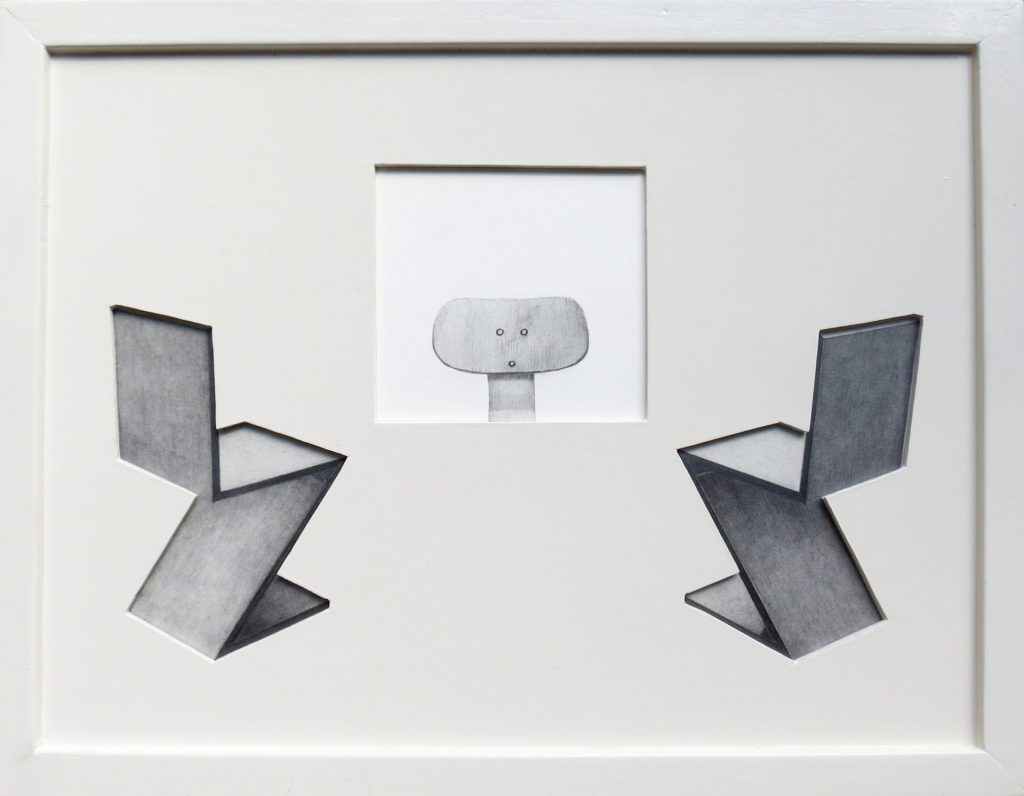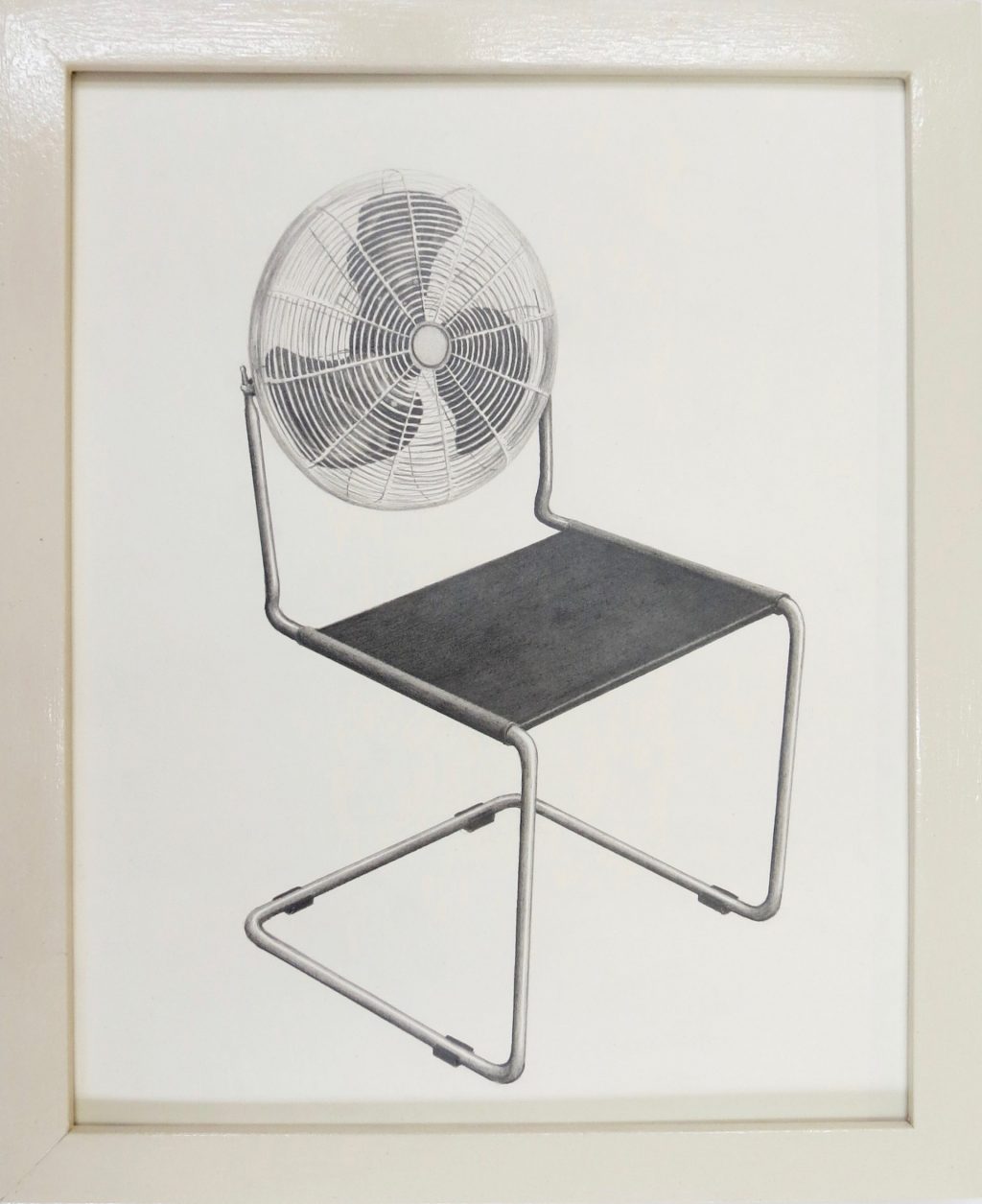2018
Comic strip
A frame is a frame, so the step to a comic is not that big in that respect. In the spirit of the great Belgian surrealist painter René Magritte and especially his famous work ‘Ceci n’est pas une pipe‘, I play a semantic game in ‘the story’ with the concept of ‘chair’ and how you can portray it.
Babylonian score
A stack to a pattern of a large number of design classics. Babylonian refers to the tower of Babel on which I have made many works. Towers of endless rows of stacked chairs. An earlier stack was the linocut ‘Stapeling’: I filled a 40 x 40 plate linoleum with a chair-shape as effectively and constructively correct as possible. Here I do that on a larger scale.
Telepathy
Telepathy is of course borrowed from the world of the comics, the comic language. Working with speech bubbles and thought bubbles. Such a form could also be a frame that you hang against the wall, what is drawn in it is then the idea. In my case I was quite busy with Rietveld at the time (2017), hence the Red-blue chair.
The great Escape
A diptych with a drawn chair back of a Cees Braakman and the other with only a framed sheet of paper. Fortunately, the list makes up for a lot. After all, it is there to protect the drawing. The question is whether that was successful in the left part?
Framed II
For many years now I have been playing with the relationship between drawing, mat, frame and wall from time to time.
Framing Rietveld is a good example and this one also plays with those elements. Frame, passe partout and of course the drawing itself, blend into one object. See also Framed III.
Look!
The attachment of the back of Cees Braakman’s chair SB02 on three points provides a whole series of possibilities without major alterations, see for example my drawings Pinocchio I, II en III or The great Escape. By zooming in on that, he/she gets something endearing. By tilting it slightly, a viewing direction is created: Look!
Fanzone
When my book ‘All in the family” was published, I made a gift in the form of a framed drawing annex luxury bookcase for a number of people who have helped me in any way. That inspired me to make more and this is (another) one of them.
See ‘Duet II‘, ‘Pin and hole‘, Ejection seat III and Painter’s seat III.
So this drawing includes that book.
Altar piece
Looking at the Jacobskapel in Venlo, I decided to limit myself to only pencil drawings for the exhibition there. I felt that it would fit better in this modest old space. But a chapel also has an altarpiece and I didn’t have one. What do I portray, within my frame of mind, in such a triptych?
Framed III
Decendants II
Descendants II is, just like the Decendants made more or less at the same time, actually a descendant of my watercolor Rietveld. The solution found there by accident has been consciously used in this work and the larger openings, in combination with the slender tubes, provide a rich palette of shadows. In addition to the first one-tubular frame chair from Mart Stam, I filled the area with all kinds of followers or descendants.
Painter’s chair III
From the luxury bookcase annex pencil drawing series. My good old office chair, it gets a bit stiff, combined with a big block brush. See also from this series Ejection seat III, Bell seat and Fanzone.
Decendants
Descendants, like Decendants II made more or less at the same time, is actually a descendant of my watercolor Rietveld. The solution found there by accident has been consciously used in this work and the larger openings, in combination with the slender tubes, provide a rich palette of shadows. In addition to the first one-tubular frame chair from Mart Stam, I filled the area with all kinds of followers or Descendants.
Quartet II
This Quartet are four of the six chairs that used to be around the dining table in mu childhood at home. I had two brothers and a sister, so a quartet of children. The chairs were of course the same size and old, but we were not. I depicted this field of tension by depicting four chairs of the same size in a skewed frame, so that the chair that is more spacious in the frame appears smaller and the other one larger.
Escher encontra Ponti
About my first pencil drawing with a chair was ‘Escher in Oirschot‘. A sport that was drawn in front of the front leg, where it actually belonged behind it. A simple procedure with major consequences for me. That ‘Escher intervention’ on this Oirschot chair led to the title mentioned. Escher has become somewhat of a generic name for these kinds of perspective interventions. So when I do that with ‘Superleggera‘ by Gio Ponti they meet (‘encontra’ in Italian).

















